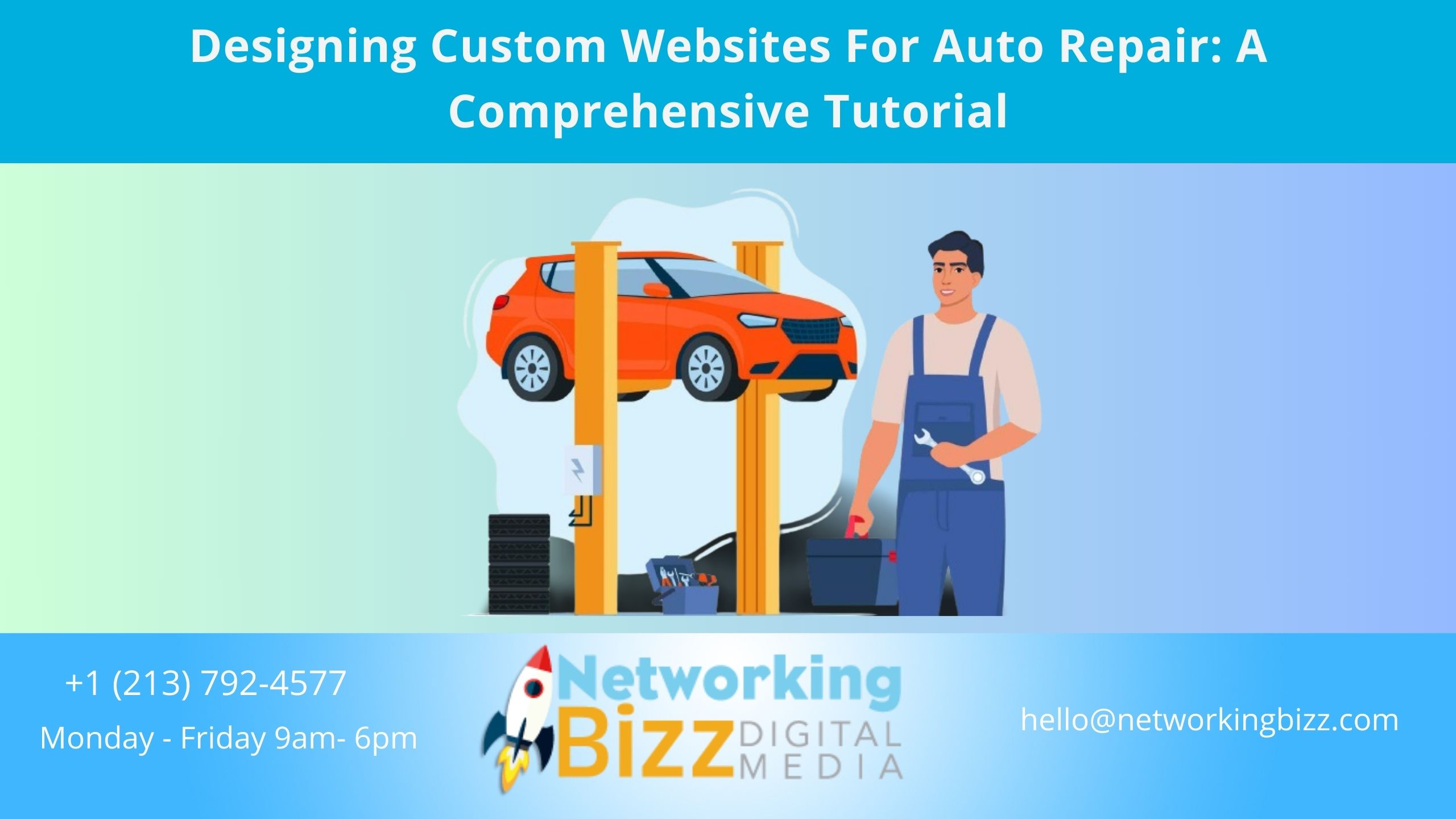Introduction
In the digital age, having a strong online presence is crucial for businesses in every industry, including auto repair shops. A well-designed website not only serves as a virtual storefront but also establishes credibility and attracts potential customers. However, creating a custom website tailored to the specific needs of an auto repair business requires careful planning and execution. In this comprehensive tutorial, we will delve into the essential steps and strategies for designing custom websites for auto repair shops, integrating networking bizz keywords to maximize visibility and reach.
Risk-Free Assurance: Experience Our 30-Day Money Back Guarantee
Unlock peace of mind with Networking Bizz Website Experts and our exclusive 100% Money Back Guarantee for 30 days. We understand the pivotal role your website plays in your business success. That’s why we extend this risk-free offer to all our small business customers. Should you find yourself dissatisfied with your website within the initial 30 days, simply reach out to us, and we’ll promptly refund your investment. Our primary goal is your complete satisfaction with your website, and our money-back guarantee ensures you receive the top-tier service you deserve. Trust in our commitment to excellence as we work tirelessly to enhance your online presence. Partner with Networking Bizz Website Experts today and embark on your digital journey with confidence.
Understanding The Importance Of A Custom Website
Before diving into the technical aspects of website design, it’s essential to recognize why having a custom website is vital for auto repair businesses. Unlike generic templates or DIY website builders, a custom website offers several advantages:
Reflecting Brand Identity: A custom website allows auto repair shops to showcase their unique brand identity, including logo, colors, and messaging, creating a memorable impression on visitors.
Optimized User Experience: By tailoring the website layout and navigation to the target audience, businesses can provide a seamless and intuitive browsing experience, leading to higher engagement and conversions.
Enhanced Functionality: Custom websites can integrate specialized features and functionalities specific to auto repair services, such as appointment scheduling, service catalogs, and online estimates, improving efficiency and customer satisfaction.
Search Engine Optimization (SEO): Custom websites offer greater flexibility in implementing SEO best practices, including keyword optimization, metadata customization, and site structure, helping businesses rank higher in search engine results.
Now that we understand the importance of a custom website let’s explore the step-by-step process of designing one for an auto repair shop, incorporating networking bizz keywords for maximum visibility.
Step 1: Define Your Goals And Target Audience
Before embarking on the design process, it’s crucial to clarify the objectives of the website and identify the target audience. For an auto repair shop, goals may include increasing online bookings, showcasing expertise in specific services (e.g., engine repair, brake service), or promoting seasonal promotions. Understanding the target audience, including demographics, preferences, and pain points, will inform design decisions and content strategy.
Networking bizz keyword integration: Conduct keyword research using tools like Google Keyword Planner or SEMrush to identify relevant keywords related to auto repair services, such as “auto repair shop,” “car maintenance,” “brake repair,” etc. Incorporate these keywords naturally into the website content, including headings, service descriptions, and meta tags, to improve search engine visibility.
Step 2: Plan Your Website Structure And Content
The next step is to outline the website’s structure and determine the content that will be included on each page. Common pages for auto repair websites include:
- Home: Introduction to the auto repair shop, highlighting key services and unique selling points.
- Services: Detailed descriptions of the services offered, including maintenance, repairs, and diagnostics, with pricing information if applicable.
- About Us: Background information about the auto repair shop, including history, team members, certifications, and testimonials.
- Contact: Contact information, including address, phone number, email, and a contact form for inquiries or appointment scheduling.
- Blog: Regularly updated blog posts covering industry news, maintenance tips, troubleshooting guides, and customer stories.
- Networking bizz keyword integration: Incorporate relevant keywords into page titles, headings, and meta descriptions to optimize each page for search engines. For example, the Services page can include keywords like “brake repair,” “oil change,” “tire rotation,” etc., to attract users searching for these specific services.
Step 3: Choose A Design And Layout
The design and layout of your website play a significant role in shaping the user experience and conveying your brand identity. When designing a custom website for an auto repair shop, consider the following factors:
- Visual Branding: Use consistent branding elements, such as logo, colors, and fonts, to create a cohesive look and feel across the website.
- Mobile Responsiveness: Ensure that the website is optimized for mobile devices, as an increasing number of users access the internet through smartphones and tablets.
- Easy Navigation: Design intuitive navigation menus and include clear calls-to-action to help visitors find the information they need and encourage conversion actions.
- High-Quality Imagery: Use high-resolution images and videos to showcase your facilities, team members, and completed projects, providing visual proof of your expertise and professionalism.
- Networking bizz keyword integration: Incorporate keywords into image filenames and alt text to improve accessibility and SEO. For example, if you’re adding an image of a brake repair service, the filename and alt text could include keywords like “brake-repair-service” or “auto-mechanic-checking-brakes.”
Step 4: Develop Compelling Content
Compelling content is the backbone of any successful website, providing valuable information to visitors and establishing authority in the industry. When creating content for an auto repair website, consider the following tips:
- Be Informative: Provide detailed descriptions of your services, explaining the procedures involved, benefits to the customer, and any warranty or guarantee offered.
- Use Visuals: Supplement written content with photos, videos, and infographics to make complex concepts easier to understand and engage visual learners.
- Showcase Expertise: Demonstrate your knowledge and experience in the auto repair industry by sharing helpful tips, case studies, and success stories.
- Encourage Action: Include clear calls-to-action (CTAs) throughout the website, prompting visitors to schedule an appointment, request a quote, or sign up for a newsletter.
- Networking bizz keyword integration: Naturally incorporate keywords into the website copy, avoiding keyword stuffing or unnatural language. Aim for a balance between SEO optimization and readability, ensuring that the content resonates with human readers while also satisfying search engine algorithms.
Step 5: Optimize For Search Engines
- Search engine optimization (SEO) is essential for driving organic traffic to your website and improving its visibility in search engine results. To optimize your auto repair website for search engines, consider the following strategies:
- Keyword Research: Identify relevant keywords and phrases that potential customers are likely to use when searching for auto repair services online.
- On-Page Optimization: Optimize meta titles, descriptions, headers, and image alt text with target keywords to improve visibility in search results.
- Local SEO: Claim and optimize your Google My Business listing to appear in local search results and attract customers in your area.
- Quality Backlinks: Earn high-quality backlinks from authoritative websites in the automotive industry, such as manufacturers, suppliers, and industry publications.
- User Experience: Ensure that your website loads quickly, is mobile-friendly, and provides a seamless browsing experience to satisfy both users and search engines.
- Networking bizz keyword integration: Leverage networking bizz keywords in off-page SEO efforts, such as guest blogging, social media engagement, and online directory listings. Participate in relevant industry forums and communities, engaging in discussions and sharing valuable insights while subtly promoting your website using targeted keywords.
Step 6: Monitor Performance And Make Improvements
Once your custom website for auto repair is live, it’s essential to monitor its performance regularly and make adjustments as needed to improve its effectiveness. Use web analytics tools like Google Analytics to track key metrics such as website traffic, bounce rate, conversion rate, and keyword rankings. Based on the data collected, make informed decisions to optimize your website for better results, whether it’s refining content, adjusting design elements, or implementing new marketing strategies.
Networking bizz keyword integration: Continuously monitor keyword rankings and organic traffic trends using SEO tools like Ahrefs or Moz. Identify opportunities to target additional networking bizz keywords or refine existing keyword targeting based on performance data. Stay updated on industry trends and changes in search engine algorithms to adapt your SEO strategy accordingly.
Comprehensive Auto Repair Website Package
Our Auto Repair custom website design package offers a comprehensive solution tailored to meet the needs of your business. Here’s what you can expect:
Professional Website Design: Your custom Auto Repair website will be crafted by our team of experts, ensuring a professional online presence that reflects the quality of your services.
E-Commerce Capability: With a built-in shopping cart feature, you can facilitate unlimited sales directly through your website, providing convenience for your customers.
Online Booking System: Seamlessly manage appointments with an online booking system that allows for unlimited bookings, streamlining your scheduling process.
Premium Features: Benefit from professional-grade website hosting, including lifetime maintenance and hosting, ensuring the reliability and security of your online platform.
Enhanced Visibility: Our package includes Google profile buildout, business listings on Facebook and 50+ platforms, and local SEO optimization to improve your online visibility and reach.
Continuous Support: Enjoy unlimited website edits and design adjustments, as well as regular online presence checks and monthly updates to keep your website current and effective.
Lead Generation: Drive business growth with a lead generation campaign, supported by content development services including writing, design, and videos to engage your audience effectively.
With our Auto Repair website design package, you’ll receive a comprehensive suite of tools and services to establish a strong online presence, attract customers, and drive business growth.
Conclusion
Designing a custom website for an auto repair shop requires careful planning, strategic execution, and ongoing optimization efforts. By following the comprehensive tutorial outlined above and integrating networking bizz keywords effectively, auto repair businesses can create a powerful online presence that attracts and engages customers while maximizing visibility and reach. Remember, the key to success lies in understanding your audience, providing valuable content and services, and continuously refining your website to meet evolving needs and preferences. With a well-designed and optimized website, auto repair shops can establish credibility, showcase expertise, and ultimately drive business growth in the digital age.




